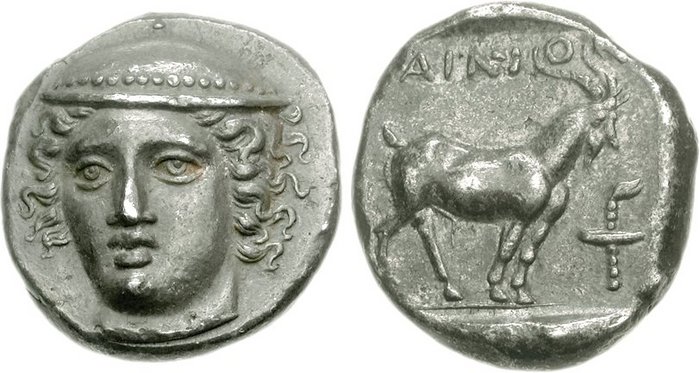AC 113 - Aenus, silver, tetradrachms (405/4-357/6 BCE)
From SILVER
404 BCE - 356 BCE Silver 14,904 kg
Description
| ObverseInscription or printing placed on the obverse.: | Head of Hermes facing slightly left, wearing petasos. |
| ReverseInscription or printing placed on the reverse.: | AINION (Greek).Goat standing right, race torch before, all within incuse square. |
Mint and issuing power
| MintIdentifies the place of manufacture or issue of a numismatic object.: | Aenus | Ancient regionAncient region.: | Thrace | Modern countryModern country: Greece | AuthorityIdentifies the issuing power. The authority can be "pretended" when the name or the portrait of X is on the coin but he/she was not the issuing power. It can also be "uncertain" when there is no mention of X on the coin but he/she was the issuing power according to the historical sources: |
Chronology
| FromIdentifies the initial date in a range assigned in a numismatic context. | 404 BCE | toIdentifies the final date in a range assigned in a numismatic context.. | 356 BCE | PeriodTime period of the numismatic object.: Classical 480-323 BC |
Physical description
| MetalThe physical material (usually metal) from which an object is made.: | Silver |
Median weightMedian of the weights of numismatic objects (in grams). in grams | 15.40 | DenominationTerm indicating the value of a numismatic object. Examples: tetradrachm, chalkous, denarius.: | tetradrachm |
StandardStandard.: |
Image

AC113 Aenus.jpeg [1]
References
| Die study referencePublication of the study: | May 19501May 1950 | ||
| Coin series referenceReference to coin series study: | RQEMAC2RQEMAC, n° 113 | ||
Obverse dies distribution
| FrequencyFrequency of specimen in distribution. ᵖ | Number of obversesNumber of obverse dies. ᵖ (o) | % (o) | Number of coinsNumber of coins. (n) | % (n) | Die nameName(s) of the die(s). |
| 1 | 12 | 31.58 | 12 | 10.53 | 205, 217, 227, 238, 239, 240, 241, 244, 245, 246, 257, 262 |
| 2 | 12 | 31.58 | 24 | 21.05 | 203, 204, 216, 228, 242, 251, 254, 255, 259, 260, 261, 263 |
| 3 | 6 | 15.79 | 18 | 15.79 | 202, 215, 236, 243, 248, 249 |
| 4 | 2 | 5.26 | 8 | 7.02 | 207, 247 |
| 5 | 2 | 5.26 | 10 | 8.77 | 218, 235 |
| 6 | 2 | 5.26 | 12 | 10.53 | 206, 226 |
| 7 | 1 | 2.63 | 7 | 6.14 | 224 |
| 23 | 1 | 2.63 | 23 | 20.18 | 230 |
| Total | 38 of 38 | 99.99 | 114 of 114 | 100.01 |
Reverse dies distribution
no distribution is available
Quantification
| Number of obversesNumber of obverse dies. ᵖ (o) | 38 | Number of singletons (o1)The number of singleton coins. ᵖ | 12 |
| Number of reverse diesNumber of reverse dies. (r) | NC"NC" is not a number. | Number of coinsNumber of coins. (n) | 114 |
| Coins per obverse dieNumber of coins per obverse die. (n/o) | 3 | Coins per reverse dieNumber of coins per reverse die. (n/r) | |
| Reverse per obverse ratioRatio of obverse dies divided by reverse dies. (r/o) | Percentage of singletons (o1)number of coins (n) divided by the number of singletons (o1) ᵖ | 31.58 % | |
| Original number of dies (O) (Carter 1983 formula)The estimation of the number of coins according to Carter 1983 ᵖ | 48.39 | Coins struck if 20,000 as average productivity per dieCoins made if the average productivity for obverses (according to Carter) is 20,000. ᵖ | 967,800 |
| Original number of dies (O) (Esty 2011 formula)The estimation of the number of coins according to the singleton formula in Esty 2011 ᵖ (O) | 57 | Survival rate if 20,000 as average productivity per dieSurvival rate if average productivity is 20,000. ᵖ | 0.00012 |
| Coverage (o = % of O) (Esty 1984 formula)Esty 1984 - coverage (% of O) ᵖ (o = % of O) | 89.47% | Die productivity if survival rate 1/2,000Average productivity if survival rate is 1/2,000. ᵖ | 4,711.72 |
| Weight of silver (in kg) if 20,000 coins per die (O = Carter formula)Carter 1983 * Median weight * 20000 (*10 if gold or electrum) ᵖ | 14,904 kg <br /> 14,904 kg | Die productivity if survival rate 1/5,000Average productivity if survival rate is 1/5,000. ᵖ | 11,779.29 |
Remarks